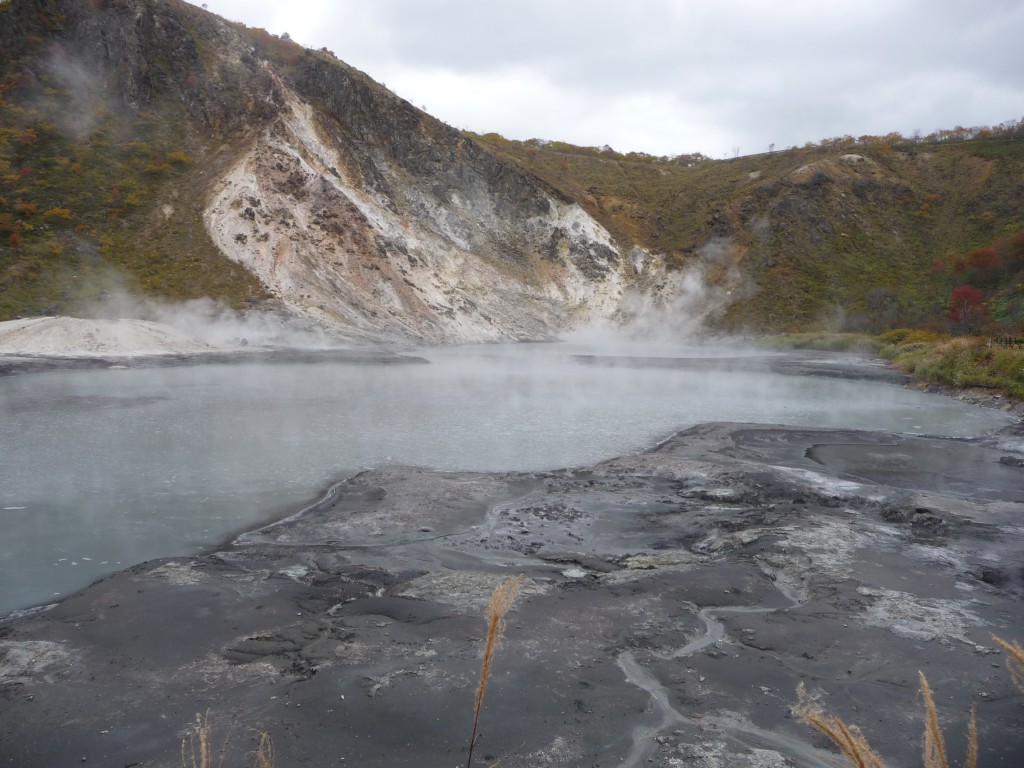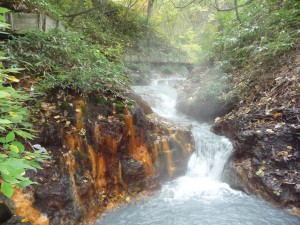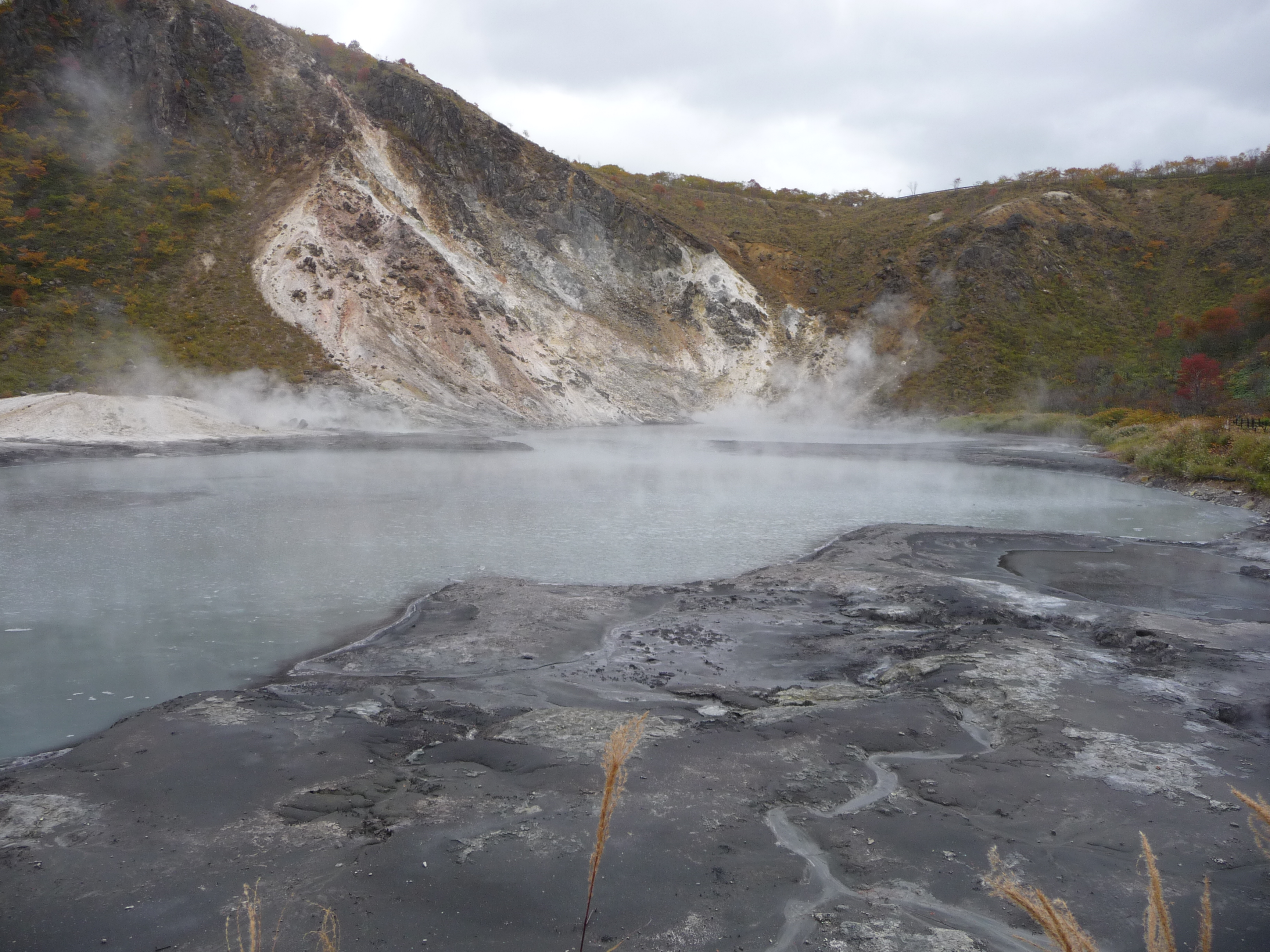Day Tripper: Noboribetsu

In Hokkaido you can tell someone to go to hell. Or you can tell them to go to Noboribetsu, which promotes itself as a sort of entrance to the underworld. This is a modern Japanese underworld, mind you, so it’s eternal damnation lite, complete with mascots and cartoon characters.
Noboribetsu is a center of geothermic activity and is crowded with onsen. My navel not being worthy of sustained contemplation, I don’t like onsen, I don’t go to onsen, and I don’t write about onsen. There’s a JR station well outside the main area of the town; if you take the train in you’ll probably want to then take a local bus or taxi to get to the hotbed of activity. We went by car instead, via the Hokkaido Expressway. For the 90-minute drive the toll was ¥2400, making me very much doubt that this particular road was paved with good intentions. We arrived late morning and decided to hike around for a bit before having lunch.
The most convenient parking lot is at the entrance to Jigokudani (Hell Valley), probably the most geothermically active area of the town, with volcanic gas vents, boiling mudpots, and the smell of sulfur permeating the air. There are a variety of overlooks available, as well as a boardwalk down to a boiling pond. We did it all, and then hiked through a variety of loop trails surrounding the Valley. These were all relatively easy and not very steep; we could have walked on to all the other attractions (everything is within a few KM) but decided instead to go back to the town for something to eat.
Noboribetsu town is not large, and its single main street seems to have the only dining options outside the hotels and onsen. The busiest restaurant (indeed, the only busy restaurant) was Daio, a mom-and-pop ramen joint at #29 Noboribetsu Onsen-cho. The wait for seats at the counter was 30 minutes and the food was worth it, even though we avoided the house specialty of “spicy ramen from hell.” After lunch came the obligatory omiyage shopping. The best choice here was Iwakura, a few doors up from Daio at #50 Noboribetsu Onsen-cho, back in the direction of Jigokudani. Iwakura sells Kuma Manjyu and freshly-made Yaki Kamaboko, and both are very nice choices indeed.
A series of booming explosions next brought us to the town’s main square, Sengen Park, where every three hours a large geyser spouts. The geyser is in a sort of semi-enclosed cavern and shoots out prodigious clouds of steam and jets of water, accompanied by the booming clapping noises that lured us there. In the small park surrounding the geyser are a series of giant iron rods in various colors, representing the clubs sinners are beaten with by devils for all eternity in hell. Ungrateful children are tormented with the red rod, murderers with the tan, thieves with the white, etc. The rods are all identically shaped, which leads to the logical conclusion that it must be the difference in color that matches the torture to the transgression. Why being beaten with a green rod over the eons is preferable to being beaten with a black rod is beyond me, but I’m sure there’s a perfectly sound theological explanation for it.
We returned to the car and drove over to Lake Kuttara. This was a small detour, but well worth it to see what a whole lot of nothing looks like. Under a leaden gray sky the shores of the lake were empty, the lake itself was empty, and beside the two-lane road running through this all the only other evidence of humanity to be seen was a small hotel, abandoned at least for the season. Kuttara was revered by the Ainu for something or the other and (so my extensive internet research assures me) in 2001 had Japan’s best quality water “in the lakes and marshes category.” Despite this accolade from the Environment Ministry, Kuttara really should be the frontrunner for the setting of the next installment of the “Ringu” franchise.

We beat a hasty retreat back over the mountain and then down to Lake Oyunuma (keep your paid parking ticket from the Jigokudani lot as it covers the lot here as well). The lake is overlooked by Mt. Hiyori, an active volcano. The lake’s waters are boiling, as are those in the attached marsh. As both areas are fenced off to protect people not smart enough to not fall into boiling water, entertainment options were rather sparse and there wasn’t much left to do except stroll past it all and back up the road for about 100 meters, where a short trail off to the right leads to the River Oyunuma Natural Footbath. There are plenty of rocks and logs here to sit on while you soak your feet; the water is very warm and pleasant and supposedly has some minerals that rejuvenate your kidneys or intestines or something in an osmosis-like process that only Japanese people understand.
There are other things to do in Noboribetsu (bear park, marine park, cherry blossom trees in the spring), but it was getting a bit late and there was still shopping to be done. The parking lot attendant at Lake Oyunuma told us that Shiraoi, the next town over, is a mecca for cheap kegani, so the cheapskates that we are off we went. Unfortunately we were seriously misinformed; the kegani price/quality combo was no better than in most Sapporo supermarkets and my faith in the wisdom of people who work in small wooden huts was seriously undermined. But we did discover that Shiraoi seems to be Hokkaido’s capital for Park Golf. We passed at least half-a-dozen courses while driving through the town, but as everybody in the car was well below 70 years of age we had no choice but to drive on without playing a single round.
The Expressway toll from Shiraoi back to Sapporo was a bargain ¥2000, so our side trip wasn’t totally worthless. We got back in good time for dinner, and with hearty appetites for it, thanks to what was, all in all, a very enjoyable day.




